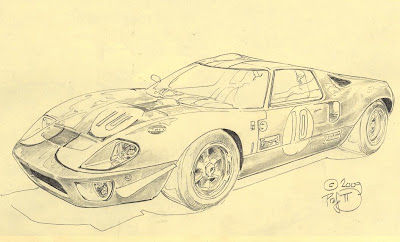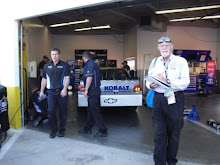Road Trip …to Sonoma and back (Part 2)
Hopefully everyone watching the race noted that Kasey cemented his race win on the restarts, pulling ahead of the 14 car going uphill through turns 2 to 4; there’s a reason why that worked, and he did it in California where you are your car.
The automobile, specifically American iron from the Detroit Big Three, was the quintessential icon of the USA at its uncontested zenith, the two decades from 1950 to 1970. And California was the epicenter of the car era.
In the 1960’s new state of the art road courses were built at Riverside, and Sears Point (Sonoma). But acting as a true bellwether for the direction that our country was headed, Riverside Raceway closed in the 1980’s and is now the site of a shopping center.
When the streets were ruled by American iron and the heart of every youngster captivated by Annette and Frankie, we all longed to be in California; trouble is too many of us actually went there.
The automobile, specifically American iron from the Detroit Big Three, was the quintessential icon of the USA at its uncontested zenith, the two decades from 1950 to 1970. And California was the epicenter of the car era.
In the 1960’s new state of the art road courses were built at Riverside, and Sears Point (Sonoma). But acting as a true bellwether for the direction that our country was headed, Riverside Raceway closed in the 1980’s and is now the site of a shopping center.
When the streets were ruled by American iron and the heart of every youngster captivated by Annette and Frankie, we all longed to be in California; trouble is too many of us actually went there.
 The mascot for Sonoma, Infineon Raceway, should be the
The mascot for Sonoma, Infineon Raceway, should be theIndy-NASCAR-American LeMans Series woodie, with a motorcycle tied to the back of it.
In the '60's racing was still the test ground of the automotive industry with series such as CAN-AM which allowed almost anything with 4 wheels and an internal combustion engine to be raced, resulting in some truly ingenious machines (unfortunately, some fatally dangerous ones, too). Going fast for long distances was still a technical challenge and the machinery had not yet overwhelmed the track designs. Road racing was the consummate test of driver, machine and technology, a few laps of racing was more informative than months or even years of running production cars at street legal speeds.
In the 1960’s Henry Ford II (Henry’s son) wanted to include one more jewel in the company crown, a testament to the most successful car brand in history, to own Ferrari and dominate racing. Enzo Ferrari didn’t just say “no,” he said “hell, no,” in such an unpleasant manner that a rebuffed Ford II returned to Detroit still stinging from his rude rejection and ordered the Ford engineers to bury Ferrari at their most prestigious event: the 24 Hours of LeMans.
 And they did; not just winning the race, but in 1967 finishing 1—2—3, several laps ahead of the nearest Ferrari in 4th.
And they did; not just winning the race, but in 1967 finishing 1—2—3, several laps ahead of the nearest Ferrari in 4th. Road racing had originated in Europe, partly for want of real estate; land was very expensive and it was much simpler to commandeer a few city streets for a race than building a track. The idea caught on in the US, and from 1908 through 1911 the world driving championship was decided in Savannah, Georgia, on a road course that used several city streets (fascinating book for history buffs, The Savannah Races by Dr. Julian K. Quattlebaum).
Oval racing was the singular province of America, starting in the 1890’s with horses running on simple dirt tracks at just about every county fair ground in the country. Bicycle companies then took advantage of the facilities and brought touring companies of riders and board tracks (assembled over the fair ground horse track) to stage races and market their product—the first iteration of “race on Sunday, sell on Monday.”
Car companies took up the idea and oval dirt track racing (along with board tracks) became a main stay of the American scene. It quickly became evident that speed was limited by a combination of the size (radius) of the turns and the banking of the track. Because the basic physics haven’t changed, this is still evident in a plot of record qualifying speed as a function of track length (as a general rule, larger tracks have bigger radius turns).
Car companies took up the idea and oval dirt track racing (along with board tracks) became a main stay of the American scene. It quickly became evident that speed was limited by a combination of the size (radius) of the turns and the banking of the track. Because the basic physics haven’t changed, this is still evident in a plot of record qualifying speed as a function of track length (as a general rule, larger tracks have bigger radius turns).
 Note that at 2.5 miles, there is a group of tracks in a vertical line with Talladega and Daytona at the top, then Indy, Pocono, Watkins Glen and Sonoma at lower qualifying speeds: it’s in the banking. Daytona is steepest at 31 degrees, then Indy at 8, Pocono with three different turns (defying all attempts at finding a set-up that is optimal for all three curves), then Watkins Glen a road course with flat corners, and slowest of all, Sonoma with flat corners and a big elevation change—160 vertical feet—equal to a 16 story building (cars can’t go up and downhill as fast as on a flat course).
Note that at 2.5 miles, there is a group of tracks in a vertical line with Talladega and Daytona at the top, then Indy, Pocono, Watkins Glen and Sonoma at lower qualifying speeds: it’s in the banking. Daytona is steepest at 31 degrees, then Indy at 8, Pocono with three different turns (defying all attempts at finding a set-up that is optimal for all three curves), then Watkins Glen a road course with flat corners, and slowest of all, Sonoma with flat corners and a big elevation change—160 vertical feet—equal to a 16 story building (cars can’t go up and downhill as fast as on a flat course).Elevation changes aren’t captured well on TV and so Sonoma is not fully appreciated by a viewing audience that hasn’t visited the venue in person, or been to some other road course track has significant elevation changes (Road Atlanta, Lanier, Georgia, being an interesting example).
It is amusing to follow the racing articles and blogs that complain about “the cookie-cutter” (somewhat similar 1.5 mile) tracks on the NASCAR circuit and then deride the tracks which really are different: Pocono and the road courses.
Shifting gears while turning left and right and also racing at the same time is an integral part of every NASCAR race, on oval courses they’re called pit stops. The majority of lead changes on oval courses now occur during pit stops, so this much maligned aspect of racing has become the best way to advance your track position on every NASCAR track. Think of road racing as very long winding pit roads with no arbitrary speed limit, just the speed limit imposed by the physics of the track and car set-up.
That Kasey Kahne secured his win by being able to pull ahead of the 14 car while going uphill is a testament to engine design and gear selection: the right engineering makes winning possible every time. Lifting a 3400 lbs car a height of 160 feet requires work, a lot of it, namely 3400 lbs x 160 ft = 544,000 ft*lbs (equal to lifting a 100 lbs weight from sea level to Denver, one vertical mile). The time in which this work is done is power (work divided by time equals power). But most significantly, the work done in lifting the 9 car ahead of the 14 isn’t done at a constant speed; the cars are accelerating. This is in racing jargon the essence of “power curve” or “power band” for an engine, the rate of work done by an engine at various speeds.

The new engine in the 9 car developed with the help of Dodge engineers has a broader power band and can provide close to maximum work over a wider speed range; this is what engine builders are paid to design and calculate. The maximum or peak power, what NASCAR measures, is still the same as before, but the power band is greatly improved.
Next week, New Hampshire, will be an entirely different problem, look back at the graph of qualifying speeds as a function of track size: New Hampshire is one of the flattest (12 degree banking) of the 1 mile tracks with the smallest turn radius, hence the lowest record qualifying speed (Phoenix, also a 1 mile track is actually flatter—11 degree banking—but has a larger radius turns, hence, qualifying speeds are about 2 mph faster than at New Hampshire
Next week, New Hampshire, will be an entirely different problem, look back at the graph of qualifying speeds as a function of track size: New Hampshire is one of the flattest (12 degree banking) of the 1 mile tracks with the smallest turn radius, hence the lowest record qualifying speed (Phoenix, also a 1 mile track is actually flatter—11 degree banking—but has a larger radius turns, hence, qualifying speeds are about 2 mph faster than at New Hampshire




No comments:
Post a Comment